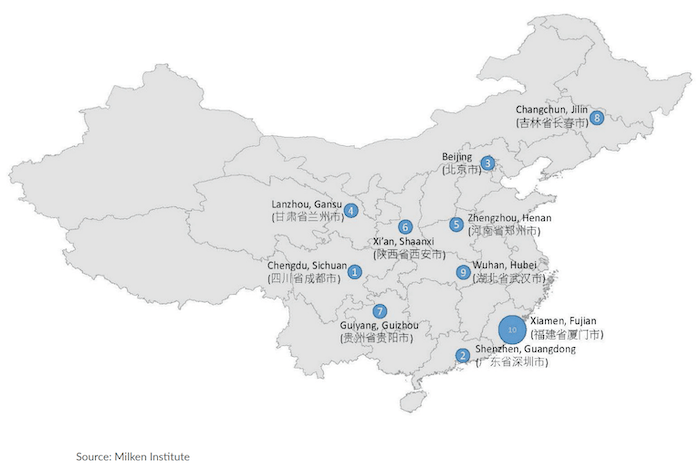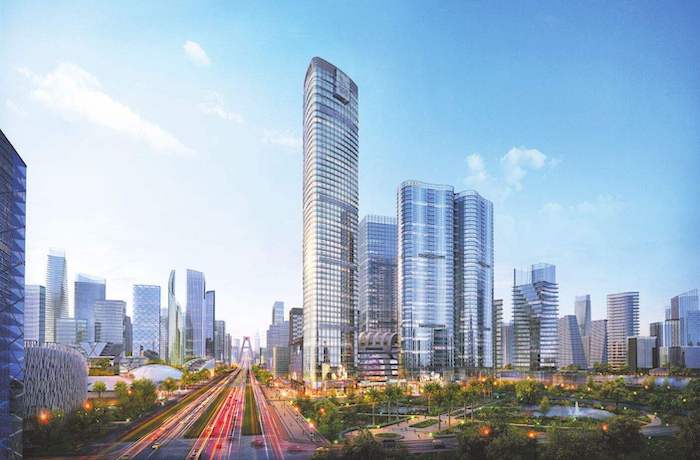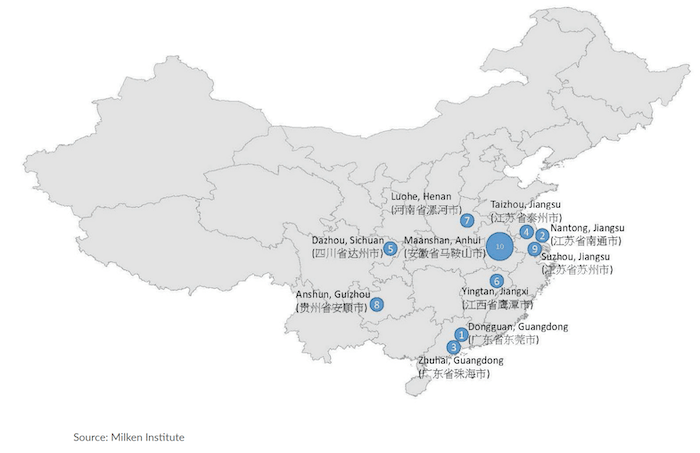Milken Institute’s Best-Performing Cities in China series has been tracking the economic performance of Chinese cities since 2015. In 2019, the top 10 in the big cities group are Chengdu, Shenzhen, Beijing, Lanzhou, Zhengzhou, Xi’an, Guiyang, Changchun, Wuhan, and Xiamen.
Milken‘s ranking index for this 2019 version comprises nine indicators—one-year (2016-2017) and five-year (2012-2017) growth for jobs, wages, and gross regional product (GRP) per capita; three-year (2014-2017) foreign direct investment (FDI) growth; FDI/GRP ratio (2017); and the location quotient (LQ) for high value-added industry employment (2017). This index categorizes Chinese cities into large and small groups to yield more meaningful comparisons and insights.
Best Performing First- and Second-tier Cities in China

- Chengdu, Sichuan (四川省成都市)
- Shenzhen, Guangdong (广东省深圳市)
- Beijing (北京市)
- Lanzhou, Gansu (甘肃省兰州市)
- Zhengzhou, Henan (河南省郑州市)
- Xi’an, Shaanxi (陕西省西安市)
- Guiyang, Guizhou (贵州省贵阳市)
- Changchun, Jilin (吉林省长春市)
- Wuhan, Hubei (湖北省武汉市)
- Xiamen, Fujian (福建省厦门市)

Chengdu in Sichuan province is ranked the best performing city in 2019. With an established industry base and extensive new high-tech build-up, Chengdu bears the fruit of the successful “western development” strategy the city embarked upon 20 years ago.
Shenzhen in the Guangdong province secures second place in the large cities group, dropping from the top rank last year (2018). Shenzhen has reinvented itself from a low-cost gadget manufacturing center to an innovation powerhouse.
The city is the birthplace of a new generation of telecom products and the tech-entrepreneur hub of China. Most recently, the Chinese government has deeded Shenzhen with the mission of “building a model city” for the world.
Beijing, the capital of China and a leader in developing the Tongzhou district, which will become the home to the Beijing municipal government, capturing the third spot with the support of an inflow of FDI.
Lanzhou, an ancient outpost and a modern gateway city to the West, takes the fourth place. Infrastructure building is driving the regional economy as the One Belt, One Road Initiative extends via there to Central Asia.
Zhengzhou, the central geographic location in Henan province, dropped one spot from 2018, ranking fifth.
This “iPhone City” is not only a production center for the international markets but also a supplier for increasingly affluent Chinese consumers.
Xi’an in Shaanxi province and Guiyang in Guizhou province are ranked sixth and seventh, respectively. Both cities are located in the western part of China, with Xi’an in the northwest and Guiyang in the southwest.
Both are experiencing an increase in infrastructure building. While Xi’an is upgrading its industry base and transportation infrastructure, Guiyang is building the next generation of energy supply, transportation, and electronic storage from the ground up.
Changchun has declined two spots from 2018. With the recent slowing of the transportation sector, the city’s automakers may generate less steam powering the city economy, despite healthy demand for high-speed rail carts and engine production.
The ongoing industry restructuring in the northeast will continue to impact the Changchun’s performance.
Wuhan advances seven spots this year. High-tech industries, such as chip-making and biomedicine, continue to add growth potential to the city’s economy.
As a coastal city, Xiamen’s economic development focus is on the integration of air-ground transportation/shipment hubs and related high-tech components.
Best Performing Third-tier Cities in China

- Dongguan, Guangdong (广东省, 东莞市)
- Nantong, Jiangsu (江苏省南通市)
- Zhuhai, Guangdong (广东省珠海市)
- Taizhou, Jiangsu (江苏省泰州市)
- Dazhou, Sichuan (四川省达州市)
- Yingtan, Jiangxi (江西省鹰潭市)
- Luohe, Henan (河南省漯河市)
- Anshun, Guizhou (贵州省安顺市)
- Suzhou, Jiangsu (江苏省苏州市)
- Maanshan, Anhui (安徽省马鞍山市)
Dongguan in the Guangdong province takes the number one spot for the second year in a row among the small cities group. In fewer than five years, Dongguan has turned from being labeled as the “Ghost Mall” city in 2012 to become a leading robotic production and artificial intelligence (AI) development center.
Nantong’s location has been its most significant asset as the nexus of both a seaport and river port while also connecting the powerhouse Shanghai and the technology center Suzhou. Industrial activities and commercial services are the key pillars of the regional economy.
Zhuhai in the Pearl River Delta cluster ranks third, as the backyard to Asia’s premium gaming center, Macao. Leisure, retirement, and business services industries define this growing city.
Taizhou in the Jiangsu province lands at the fourth spot. The city has been on the top 10 list since the inception of this report series.
Ranked at fifth and sixth are Dazhou in the Sichuan province, and Yingtan in Jiangxi, respectively. It is the first time Dazhou and Yingtan have ranked in the top 10 list. Both cities’ have agriculture- and mining-based economies that are evolving into modern manufacturing and food processing centers. They are both also river transportation hubs in their respective regions.
Luohe in the Henan province ranks at the seventh spot and is the only agricultural-based economy that has appeared on the top 10 ranking twice.
Ranked the eighth is Anshun in the Guizhou province. Both national and local policies and a renewed drive to add technologies into a traditional beverage production elevate its economic performance.
Suzhou in Jiangsu province is placed at the ninth spot. As the first Science and Technology Park joint-venture between the city and the Singaporean government, Suzhou has been the technology powerhouse in the Yangtze River Economic cluster.
Maanshan has emerged from an old steel industry base to become a newer, more diversified manufacturing powerhouse. Its proximity to the city of Nanjing, the capital of the Jiangsu province, provides the
city with strong R&D support.